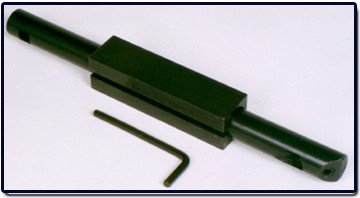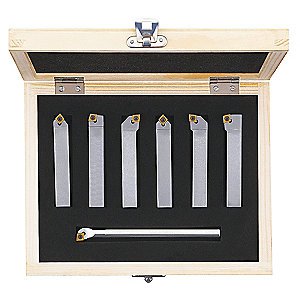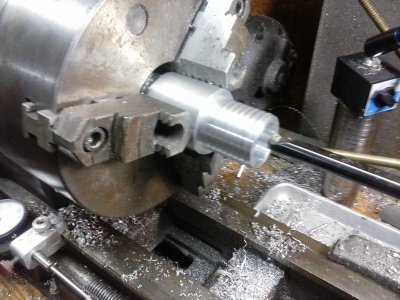I am well aware of the pros and cons of a 4-way tool post, having used one extensively. However, I disagree that it is the best way to hold a boring bar. This is not just about the stability of the tool post itself. It is about how well the bar is held in the tool holder.
A round bar held in a slot that locks the bar down with screws provides contact at two very small spots on the bar provided that you shim the inside of the slot to bring the screws on center. You must also shim the bar evenly to bring the tip of the cutter 0.005-0.010" above center. In addition, the screws may, and often do, displace the bar, causing misalignment. Given that the tangential forces experienced by the bar tend to twist the bar, this arrangement is the worst way to hold a boring bar.
The most rigid method of holding a boring bar is in a holder that completely encases the circumference of the bar in a finely finished and hardened bore. Ideally, this holder will be 3-4 times the diameter of the bar being held. Screws are then used to tighten the circumference of the holder to rigidly hold the bar in place, thereby reducing vibration and the possibility of the bar moving as it cuts. An example of such a holder is the Aloris 4D; it is not a coincidence that this holder for 3/4" diameter bars is 3" long, finely finished and hardened.
It is well known that a QCTP can easily sustain the cutting forces encountered while boring. I own an Aloris AXA post that holds a 3/4" bar under full extension quite well but even my little OXA post can handle a 3/8" carbide bar at full extension, 4" deep in a hole. The issue when boring is not just the downward (tangential) pressure like it is with external turning. It is the tangential
and radial forces that we have to contend with and a good holder is the best way to achieve that.
Don't take my word for it. See this article by
Dr. Uwe Heinrich of Micro 100:
http://www.ctemag.com/pdf/2005/0512-Boring.pdf
I never said the 4 way was the best.
I merely said that by it's very nature it is more rigid.
Boring bars for 4 way posts have a square sleeve for clamping, or have flats ground onto them.
As for deflection, if you are deflecting a flat or un-sleeved 3/4" (or even a 1/2") bar in any meaningful way, they you are way past proper torque.


(the set on the right is a Micro 100 set)
I am not sure what your point is. We all know that Aloris and other style QCTP's do the job for boring, and we all know that shimming is a drag (I even pointed that out). None of this changes the points I made above. As for a carbide bar, the OP was pretty clear that he did not want to spend the money on a piece of tool steel for just this job, I think it is safe to say that a carbide bar is also out of the question.
As for Dr. Heinrich, all I can say is be wary of a person who wears a lab coat and writes sales brochures. Those of us that have math degrees know that all we have to do is write a little bit of symbolic math and every one goes "OK, I take your word for it because you are obviously smarter than me." Any time I want my boss to leave me alone, I just start babbling about PDE's or the pros and cons of different ways of arriving at R^2 and she goes away. Seriously, I can just picture a conversation between a shop foreman and a machinist using Dr. Heinrich's math:
Boss: "Uhhhh, Bob, what are you doing?"
Bob: "Setting up the machine for boring."
Boss: "You need a calculator for that?"
Bob: "I have to calculate the modulus of deflection so I know how far above the centerline to set the tool."
Boss: <blank stare>
Bob: "See, the tool will flex down when I start the cut. Not only that, the tool will twist, so I also have to calculate the optimal depth of cut so the tool comes in line when it is under load."
Boss: "Ummm..."
Bob: "I am having a bit of trouble with this though. The optimal depth of cut does not work out with the chip load of my tool when I try to figure feed and speed."
<pregnant silence>
Bob: "I was about to call Dr. Heinrich at Micro 100 and see if he can help me get this straightened out."
Boss: "You're fired."
I suppose that a CNC machine dedicated to high production output of a single part would be set up like this. But this is a hobby forum, and we tend to use the "cut and adjust" method.
We can spend all day discussing clamping length, smoothness of clamping surface, etc. So we clamp our 3/4" boring bar into a 3" long holder full of confidence that we have a rigid set up. Then we drop the tool holder into a tool post that only has about a 2" diameter contact ring with the cross slide. A chain is only a strong as the weakest link.
A 4 way tool post is substantially larger than a QCTP, and has substantially more contact area with the cross slide. typically, you can also put a much larger tool into a 4 way than into a QCTP. Now, I agree that putting a round tool in a square slot will give poor results some of the time, but this is not the fault of the tool post, it is the fault of the user for not using the right tool.
Personally, I despise the 4way, and use an Aloris style QCTP. I am just not a blind to the fact that I gave up some rigidity for convenience. I have no experience with a real Aloris. Maybe it really is as rigid as a 4 way. I will probably never know, I can buy a used lathe for the price of an Aloris set.




